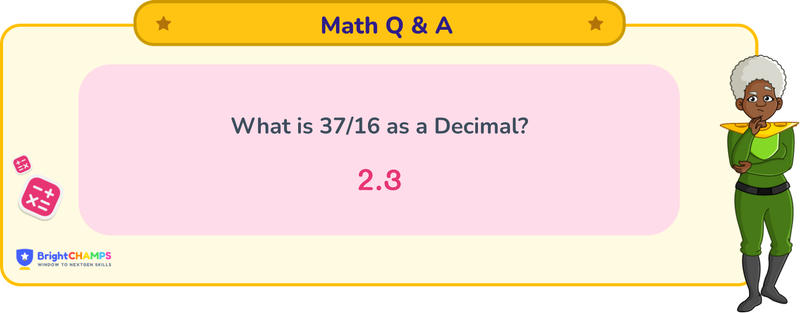
 188 Learners
188 LearnersLast updated on August 5, 2025

37/16 as a Decimal

It is a simple question on decimal conversion. Firstly, we have to learn fractions and decimals. A fraction represents a part of the whole. It has two parts: the numerator (number on the top), here 37, which represents how many parts out of the whole, and the denominator (number below), here 16, which shows how many parts make the whole. A decimal is a way to represent a number that is not whole, using a (.) or a decimal to separate the whole part from the fractional part. The numbers to the left of the decimal point represent the whole, and those to the right represent the fractional part.
What is 37/16 as a decimal?

Answer
37/16 in decimals can be written as 2.3125. It is a terminating decimal, meaning it does not repeat infinitely.
Explanation
To convert 37/16 into a decimal, we will use the division method. Let's see the step-by-step breakdown of the process:
Step 1: Identify the numerator and denominator because the numerator (37) will be taken as the dividend, and the denominator (16) will be taken as the divisor.
Step 2: Divide 37 by 16.
Step 3: 16 goes into 37 two times, as 16 × 2 = 32. Write 2 in the quotient place. Subtract 32 from 37, which gives 5.
Step 4: Bring down a 0, making it 50.
Step 5: 16 goes into 50 three times, as 16 × 3 = 48. Write 3 in the quotient place next to 2. Subtract 48 from 50, which gives 2.
Step 6: Bring down another 0, making it 20.
Step 7: 16 goes into 20 one time, as 16 × 1 = 16. Write 1 in the quotient place. Subtract 16 from 20, which gives 4.
Step 8: Bring down another 0, making it 40.
Step 9: 16 goes into 40 two times, as 16 × 2 = 32. Write 2 in the quotient place. Subtract 32 from 40, which gives 8.
Step 10: Bring down another 0, making it 80.
Step 11: 16 goes into 80 five times, as 16 × 5 = 80. Write 5 in the quotient place. Subtract 80 from 80, which gives 0.
The division process ends with a remainder of 0, indicating that 37/16 as a decimal is 2.3125.
Important Glossaries for 37/16 as a decimal
- Fraction: A numerical quantity that is not a whole number, representing a part of a whole.
- Decimal: A number that uses the base ten and includes a decimal point to separate the whole part from the fractional part.
- Numerator: The top part of a fraction, indicating how many parts of the whole are being considered.
- Denominator: The bottom part of a fraction, showing how many parts make up a whole.
- Terminating Decimal: A decimal that ends and does not repeat infinitely.




